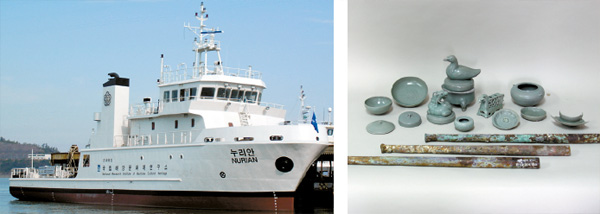Underwater archaeologists face aquatic thievery

A 33-centimeter (13-inch) celadon piece from the Goryeo Dynasty (918-1392) that thieves attempted to steal. Provided by CHA
Unfortunately, these underwater relics also attract thieves eager to plunder these national treasures for their own gain.
Korea’s Cultural Heritage Administration recently regretfully announced that two of its own officials conspired with a private diver to steal a 33-centimeter (13-inch) piece of celadon dating from the Goryeo Dynasty (918-1392) from an underwater archaeological exploration off the waters of Jindo Island in South Jeolla.
Making the incident all the more shocking is that the excavation, which took place between April 28 and Nov. 1, was being led by the National Research Institute of Maritime Cultural Heritage, which is a part of the heritage administration.
Goryeo celadon
According to the Cultural Heritage Administration, the three thieves worked as a team.
“During the second round of underwater archaeological excavations, which took place in waters near Oryu-ri, Gogun township in Jindo County, the theft took place,” said the heritage administration in a statement last week. “Police are currently investigating the case.”
The three are suspected of secretively removing the Goryeo celadon and taking it to the private diver’s home. The celadon is a type called maebyeong, which is a sort of long jar with a small opening, broad top and narrow bottom, and is believed to have been made some time around the 14th century.
The heritage administration said that although a team of two divers was conducting the exploration, the visibility in the murky waters off Oryu-ri was so low - often just 10 centimeters (2 inches) - that a diver could easily take something without another diver noticing.
But last month, the research institute grew suspicious that something was wrong, and an investigation caused the celadon to turn up on Oct. 19. The three are currently being questioned by the Mokpo police at the largest city close to Jindo Island.
An ironic theft
The biggest irony here is that the whole reason Korean researchers learned of the treasure trove of relics in the waters off Oryu was because of another theft.
These waters were the site of the Battle of Myeongnyang Strait on Sept. 16, 1597, one of the most famous naval encounters from the Imjin War. On that day, Admiral Yi Sun-shin’s fleet of 13 ships defeated a force of 133 Japanese vessels.
In addition, this area was the main sea route from Gangjin County, where Goryeo artisans made celadon pieces, to the royal palaces in the Goryeo capital of Gaeseong (today known as Kaesong).
So academics knew the history of the area, but no one realized how much bounty was still in the water until a ring of cultural-property thieves was caught in November 2011, illegally excavating Goryeo celadon. That’s when archaeologists discovered just how rich these waters could be.
The National Research Institute of Maritime Cultural Heritage began a preliminary survey in September the next year, which turned up 32 celadon pieces as well as nine stone anchors.
That early success led the research institute to make a full survey of just one small section - just 0.8 percent of the total area they want to examine - from Oct. 4 to Nov. 25 in 2012, which led to the discovery of about 120 relics, including guns, bullets and pale green-blue celadon works from the Goryeo Dynasty.
Such rich findings caused the Cultural Heritage Administration to designate about 90,000 square meters (22 acres) as an important cultural heritage and began a second survey in April, with hopes of finding more relics and, perhaps, full boats. Korea has unearthed only 11 ancient boats, although records say 31 were sunk by Admiral Yi’s fleet in the Battle of Myeongnyang Strait.
High hopes
Five years ago, another underwater theft took place in a state-initiated archaeological exploration.
This one happened near Taean’s Mado Island in South Chungcheong, where many of Korea’s ancient ships are known to have sunk. Numerous items, such as wooden sales records, ceramics and golden and wooden artifacts have been found, making the area famous among Korean archaeologists.
In the middle of the exploration, which also was led by the National Research Institute, one private diver managed to smuggle 19 pieces of Goryeo celadon, including a lion-shaped incense burner, before he was caught by police.
At the time, there were suspicions the diver was working with officials from the research institute, but nothing was ever proven.
In both cases - in Mado and Jindo - divers took advantage of the difficult circumstances presented in underwater archaeological excavations, most notably extremely poor visibility. Off of Korea’s west and south coasts, visibility is often less than a meter, making it very difficult to keep an eye on what’s going on in the water, even by other nearby underwater explorers.
“It’s total darkness down there,” said Moon Hwan-sik, a manager at the institute’s underwater excavation and conservation division. Moon said that when tidal currents are at their weakest, visibility can extend as far as 30 meters, but when currents are bad visibility drops to zero.

The Korean government introduced the Nurian, left, last year for underwater archaeological explorations. The waters off Oryu, right, are thought to be full of lost treasures. Provided by CHA
However, underwater archaeology is something that Korea is highly invested in, and it claims to be the best in Asia.
In December last year, the Korean government introduced a brand new ship - named the Nurian - dedicated solely to underwater archaeology. The 290-ton ship is designed to allow 20 investigators stay on the ship for 20 days and focus on underwater surveying.
The ship went on its first exploration in June, traveling to waters near Incheon where 700 Goryeo celadon pieces were found.
“With Nurian, Korea has laid the groundwork for the advancement of underwater archaeology,” said Seong Nak-jun, the research institute’s former chief, when the ship was introduced. Seong added that people can expect to see Korea playing an active role in global underwater archaeology.
But it seems the safety of its own underwater cultural property is something that Korea should be more concerned about at the moment.
By Kim Hyung-eun [hkim@joongang.co.kr]










with the Korea JoongAng Daily
To write comments, please log in to one of the accounts.
Standards Board Policy (0/250자)